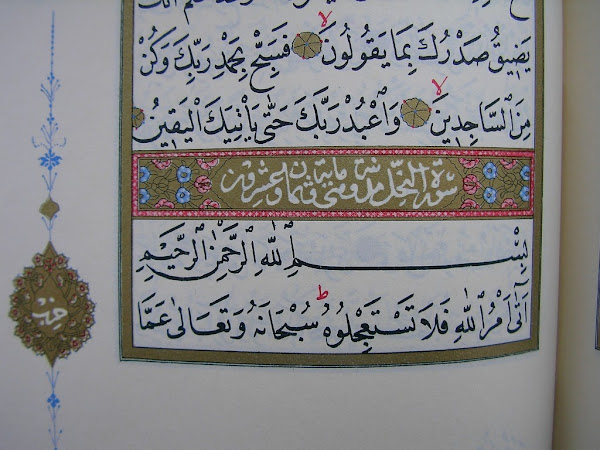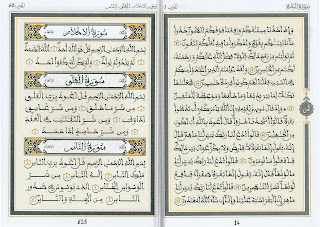The Egyptian Goverment Edition printed in Gizeh in 1924
was the first offset printed mushaf,
It was type set (not type printed).
It used smaller subset of the Amiriyya font not because the Amiriyya laked the
technical possibility for more elaborate ligatures,
((in 1881 when they printed a muṣḥaf for the first time,
they used 900 different sorts, in 1906 they reduced it to about 400,
which they used in the backmatter of the 1924 muṣḥaf,
in the qurʾānic text even less))
but to make the qurʾānic text easier to read for state school educated (wo-)men.
They did not want that the words "climb" at the end of the line for lack of space,
nor that some letter
are above following letters.
It is elegant how the word continues above to the right of the baseline waw,
but it is against the rational mind of the 20th century: everything must be right to left!
The kind of elegance you have with "bi-ḥamdi rabbika" is not valued by modern intelectuals.
Here you see on the right /fī/, on the left /fĭ/, a distinction gone in 1924:
And here you see, with which vowel the alif-waṣl has to be read ‒
something not shown in the KFE.
In Morocco they always show with which vowel one has to start (here twice fatḥa), IF one starts although the first letter
is alif-waṣl, the linking alif, with is normaly silent.
In Persia and in Turkey one shows the vowel only after a pause, like here:
Both in the second and third line an alif waṣl comes after "laziM", a necessary pause, so there is a vowel sign between the usual waṣl and the alif ‒ a reading help missing in Gizeh 1924.
Wednesday, 26 May 2021
nūn quṭnī نون قطني nūn ṣila نون صلة
In Ḥafṣ ʿan ʿĀṣim there are about fifty places
where alif waṣl followes tanwin
linked with kasra /ini/.Asia writes a small(quṭnī) nūn.
Here a Persian last page (with wa- at the end of line 1 it can only be from a farsiphone enviroment). After the first verse there is "la": no need to stop; if one stops, the first word of verse 2 has a hamza-fatha ‒ although the word is normally written with alif-waṣla. But WHEN/IF one joins, it becomes /ʾaḥaduni-llāh/ ‒ note the hamza-fatha on /ʾaḥadun/. Muḥammad Ṣadīq al-Minšāwī recites it both ways.
Tuesday, 25 May 2021
al-Wāqiʿa 2 / kāḏība
In Baqara 72 I showed that "Medina" makes undocumented changes to Būlāq52.
Here I show that Qaṭar made another change to Būlāq52 ‒ again without explanations. The Iranian Center for Printing and Distributing the Qurʾān (Ṭabʿo Našr) developed a new rasm, a new orthography and new vowelled waṣl signs. After studying the literature on writing the muṣḥaf and 26 important maṣāḥif from different regions and different riwāyāt, they publish their results and their reasons.
In Indonesian there was a commitee of ʿulema from all over the country that deliberates 1974 to 1983 and fixed a standard, a second comittee revisted the standard in 2002, and a third from 2015 to 2018.
Here I show that Qaṭar made another change to Būlāq52 ‒ again without explanations. The Iranian Center for Printing and Distributing the Qurʾān (Ṭabʿo Našr) developed a new rasm, a new orthography and new vowelled waṣl signs. After studying the literature on writing the muṣḥaf and 26 important maṣāḥif from different regions and different riwāyāt, they publish their results and their reasons.
In Indonesian there was a commitee of ʿulema from all over the country that deliberates 1974 to 1983 and fixed a standard, a second comittee revisted the standard in 2002, and a third from 2015 to 2018.
Sunday, 23 May 2021
Morocco ... Muṣḥaf al-Muḥammadī
To commemorate Hassan II's silver jubilee and later Muhammads VI's accession to the throne the Kingdom
published editions in maghrebian style ‒ both in colour and back&white.
I looked in vain for information about the printing place.
This could be the reason the reserve::  The press wasn't in the Sherifian Kingdom, but in Cairo. Al-Muǧallad al-ʿArabi (often printers make up names for special occasions) was in charge.But the third edition was home made ‒ in a press founded in Faḍāla (named Muhammedia since 1959) after WWII and bought in the 1960ies by the Minstery for Religious Affairs and Pious Foundations al-Maṭbaʿ al-Faḍāla.
The press wasn't in the Sherifian Kingdom, but in Cairo. Al-Muǧallad al-ʿArabi (often printers make up names for special occasions) was in charge.But the third edition was home made ‒ in a press founded in Faḍāla (named Muhammedia since 1959) after WWII and bought in the 1960ies by the Minstery for Religious Affairs and Pious Foundations al-Maṭbaʿ al-Faḍāla.


 While under Hassan II there was only one Royal Muṣḥaf (in cheap and in expensive editions) ‒ written by seven Moroccan calligraphers
While under Hassan II there was only one Royal Muṣḥaf (in cheap and in expensive editions) ‒ written by seven Moroccan calligraphers
 there are new four different ones:
‒ one hand written, similar to his father's
there are new four different ones:
‒ one hand written, similar to his father's ‒ one computer set ‒ "andalusian", i.e. with green dots for hamzat,
‒ one computer set ‒ "moroccan"and the same in an expensive edition:
and with reduced colours:
‒ one with images of wooden tablets from madrasas‒ printed 2007 in Graz, Austria.
‒ one computer set ‒ "andalusian", i.e. with green dots for hamzat,
‒ one computer set ‒ "moroccan"and the same in an expensive edition:
and with reduced colours:
‒ one with images of wooden tablets from madrasas‒ printed 2007 in Graz, Austria.
 The press wasn't in the Sherifian Kingdom, but in Cairo. Al-Muǧallad al-ʿArabi (often printers make up names for special occasions) was in charge.But the third edition was home made ‒ in a press founded in Faḍāla (named Muhammedia since 1959) after WWII and bought in the 1960ies by the Minstery for Religious Affairs and Pious Foundations al-Maṭbaʿ al-Faḍāla.
The press wasn't in the Sherifian Kingdom, but in Cairo. Al-Muǧallad al-ʿArabi (often printers make up names for special occasions) was in charge.But the third edition was home made ‒ in a press founded in Faḍāla (named Muhammedia since 1959) after WWII and bought in the 1960ies by the Minstery for Religious Affairs and Pious Foundations al-Maṭbaʿ al-Faḍāla.


 While under Hassan II there was only one Royal Muṣḥaf (in cheap and in expensive editions) ‒ written by seven Moroccan calligraphers
While under Hassan II there was only one Royal Muṣḥaf (in cheap and in expensive editions) ‒ written by seven Moroccan calligraphers
 there are new four different ones:
‒ one hand written, similar to his father's
there are new four different ones:
‒ one hand written, similar to his father's ‒ one computer set ‒ "andalusian", i.e. with green dots for hamzat,
‒ one computer set ‒ "moroccan"and the same in an expensive edition:
and with reduced colours:
‒ one with images of wooden tablets from madrasas‒ printed 2007 in Graz, Austria.
‒ one computer set ‒ "andalusian", i.e. with green dots for hamzat,
‒ one computer set ‒ "moroccan"and the same in an expensive edition:
and with reduced colours:
‒ one with images of wooden tablets from madrasas‒ printed 2007 in Graz, Austria.
Subscribe to:
Comments (Atom)
Nairīzī
Mirza Aḥmad an-Nairīzī (ca. 1650–1747) is the last of the classical Iranian calligraher s. Informations are hard to find, because often und...

-
40 years ago Adrian Alan Brockett submitted his Ph.D. to the University of St.Andrews: Studies in Two Transmissions of the Qurʾān . Now...
-
There are several types of madd sign in the Qurʾān, in South Asian masāhif: madd al-muttasil for a longer lengthening of the vowel used...
-
Although it is often written that the King Fuʾād Edition fixed a somehow unclear text, and established the reading of Ḥafṣ according to ʿĀ...

























